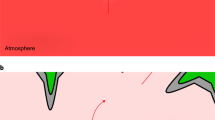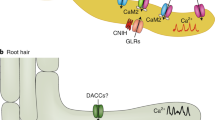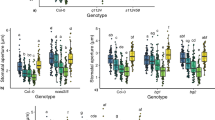Abstract
Oscillations in cytosolic calcium concentration ([Ca2+]cyt) are central regulators of signal transduction cascades1, although the roles of individual [Ca2+]cyt oscillation parameters in regulating downstream physiological responses remain largely unknown. In plants, guard cells integrate environmental and endogenous signals to regulate the aperture of stomatal pores2 and [Ca2+]cyt oscillations are a fundamental component of stomatal closure3,4. Here we systematically vary [Ca2+]cyt oscillation parameters in Arabidopsis guard cells using a ‘calcium clamp’3,5,6,7 and show that [Ca2+]cyt controls stomatal closure by two mechanisms. Short-term ‘calcium-reactive’ closure occurred rapidly when [Ca2+]cyt was elevated, whereas the degree of long-term steady-state closure was ‘calcium programmed’ by [Ca2+]cyt oscillations within a defined range of frequency, transient number, duration and amplitude. Furthermore, in guard cells of the gca2 mutant8, [Ca2+]cyt oscillations induced by abscisic acid and extracellular calcium had increased frequencies and reduced transient duration, and steady-state stomatal closure was abolished. Experimentally imposing [Ca2+]cyt oscillations with parameters that elicited closure in the wild type restored long-term closure in gca2 stomata. These data show that a defined window of guard cell [Ca2+]cyt oscillation parameters programs changes in steady-state stomatal aperture.
This is a preview of subscription content, access via your institution
Access options
Subscribe to this journal
Receive 51 print issues and online access
$199.00 per year
only $3.90 per issue
Buy this article
- Purchase on Springer Link
- Instant access to full article PDF
Prices may be subject to local taxes which are calculated during checkout





Similar content being viewed by others
References
Berridge, M. J. The AM and FM of calcium signalling. Nature 386, 759–760 (1997).
MacRobbie, E. A. C. Signalling in guard cells and regulation of ion channel activity. J. Exp. Bot. 48, 515–528 (1997).
Allen, G. J. et al. Alteration of stimulus-specific guard cell calcium oscillations and stomatal closing in Arabidopsis det3 mutant. Science 289, 2338–2342 (2000).
McAinsh, M. R. & Hetherington, A. M. Encoding specificity in Ca2+ signalling systems. Trends Plant Sci. 3, 32–36 (1998).
Gu, X. & Spitzer, N. C. Distinct aspects of neuronal differentiation encoded by frequency of spontaneous Ca2+ transients. Nature 375, 784–787 (1995).
Dolmetsch, R. E., Xu, K. & Lewis, R. S. Calcium oscillations increase the efficiency and specificity of gene expression. Nature 392, 933–936 (1998).
De Koninck, P. & Schulman, H. Sensitivity of CaM kinase II to the frequency of Ca2+ oscillations. Science 279, 227–230 (1998).
Himmelbach, A., Iten, M. & Grill, E. Signalling of abscisic acid to regulate plant growth. Phil. Trans. R. Soc. Lond. B 353, 1439–1444 (1998).
Li, W. et al. Cell-permeant cage InsP3 ester shows that Ca2+ spike frequency can optimize gene expression. Nature 392, 936–941 (1998).
Gomez, T. M & Spitzer, N. C. In vivo regulation of axon extension and path finding by growth-cone calcium transients. Nature 397, 350–355 (1999).
Camacho P, & Lechleiter, J. D. Increased frequency of calcium waves in Xenopus laevis oocytes that express a calcium-ATPase. Science 260, 226–229 (1993).
Dal Santo, P., Logan, M. A., Chisholm, A. D. & Jorgensen, E. M. The inositol trisphosphate receptor regulates a 50-second behavioral rhythm in C. elegans. Cell 98, 757–767 (1999).
Felle, H. Auxin causes oscillations of cytosolic free calcium and pH in Zea mays coleoptiles. Planta 174, 495–499 (1988).
McAinsh, M. R., Webb, A. A. R., Taylor, J. E. & Hetherington, A. M. Stimulus-induced oscillations in guard cell cytoplasmic free calcium. Plant Cell 7, 1207–1219 (1995).
Ehrhardt, D. W., Wais, R. & Long, S. R. Calcium spiking in plant root hairs responding to rhizobium nodulation signals. Cell 85, 673–681 (1996).
Holdaway-Clarke, T. L., Feijó, J. A., Hackett, G. R., Kunkel, J. G. & Hepler, P. K. Pollen tube growth and intracellular cytosolic calcium gradient oscillate in phase while extracellular calcium influx is delayed. Plant Cell 9, 1999–2010 (1997).
Staxén, I. et al. Abscisic acid induces oscillations in guard-cell cytosolic free calcium that involve phosphoinositide-specific phospholipase C. Proc. Natl Acad. Sci. USA 96,1779–1784 (1999).
Trewavas, A. J. & Malho, R. Ca2+ signalling in plant cells: the big network! Curr. Opin. Plant Biol. 1, 428–433 (1998).
Miyawaki, A., Griesbeck, O., Heim, R. & Tsien, R. Y. Dynamic and quantitative Ca2+ measurements using improved cameleons. Proc. Natl Acad. Sci. USA 96, 2135–2140 (1999).
Allen, G. J. et al. Cameleon calcium indicator reports cytoplasmic calcium dynamics in Arabidopsis guard cells. Plant J. 19, 735–747 (1999).
Gilroy, S., Fricker, M. D., Read, N. D. & Trewavas, A. J. Role of calcium in signal transduction of commelina guard-cells. Plant Cell 3, 333–344 (1991).
Grabov, A. & Blatt, M. R. Membrane voltage initiates Ca2+ waves and potentiates Ca2+ increases with abscisic acid in stomatal guard cells. Proc. Natl Acad. Sci. USA 95, 4778–4783 (1998).
Hamilton, D. W., Hills, A., Kohler, B. & Blatt, M. R. Ca2+ channels at the plasma membrane of stomatal guard cells are activated by hyperpolarization and abscisic acid. Proc. Natl Acad. Sci. USA 97, 4967–4972 (2000).
Pei, Z. M. et al. Hydrogen peroxide-activated Ca2+ channels mediate guard cell abscisic acid signalling. Nature 406, 731–734 (2000).
Koornneef, M., Reuling, G. & Karssen, C. M. The isolation and characterisation of abscisic acid-insensitive mutants of Arabidopsis thaliana. Physiol. Plant 61, 377–383 (1984).
Cutler, S., Ghassemian, M., Bonetta, D., Cooney, S. & McCourt, P. A protein farnesyl transferase involved in abscisic acid signal transduction in Arabidopsis. Science 273, 1239–1241 (1996).
Pei, Z. M., Ghassemian, M., Kwak, C. M., McCourt, P. & Schroeder, J. I. Role of farnesyltransferase in ABA regulation of guard cell anion channels and plant water loss. Science 282, 287–290 (1998).
Pei, Z. M. et al. Differential abscisic acid regulation of guard cell slow anion channels in Arabidopsis wild-type and abi1 and abi2 mutants. Plant Cell 9, 409–423 (1997).
Schroeder, J. I. & Hagiwara, S. Repetitive increases in cytoplasmic Ca2+ of guard cells by abscisic acid activation of non-selective Ca2+-permeable channels. Proc. Natl Acad. Sci. USA 87, 9305–9309 (1990).
Blatt, M. R. Ca2+ signalling and control of guard-cell volume in stomatal movements. Curr. Opin. Plant Biol. 3, 196–204 (2000).
Acknowledgements
We thank J. Harper for discussions and N. Spitzer and R. Tsien for comments on the manuscript. This research was supported by NIH, Department of Energy and National Science Foundation grants to J.I.S. and a DFG grant and Fonds der Chemischen Industrie to E.G.
Author information
Authors and Affiliations
Corresponding author
Supplementary information

Supplementary data Figure 1
(GIF 20.7 KB)
Hyperpolarization-activated "calcium-clamp" and [Ca2+]cyt oscillations in Arabidopsis guard cells expressing yellow cameleon 2.1.
(a) Stomata were opened in high KCl (100 mM) (depolarizing) buffer for 2.5h in the light. Guard cells subsequently exhibited a stable resting [Ca2+]cyt level in the 100 mM KCl buffer. (b) Stomatal aperture was stable after the 2.5 h opening period (t=0) and for a subsequent 3 h period (t=3) when cells were maintained in the 100 mM KCl buffer. (c) Repetitive exchanges to low KCl (0.1 mM) hyperpolarizing buffer induced a series of [Ca2+]cyt transients composing a [Ca2+]cyt oscillation (upper panel). Oscillations were abolished if extracellular calcium was removed with 10 mM EGTA (lower panel). (d) Steady-state stomatal closure was induced when five hyperpolarizations of 5 min duration and a 10 min period (5 x 5) were applied in the presence of extracellular calcium, but was reduced in the absence of extracellular calcium (5 x 5 + EGTA). Apertures were measured 3 h following the onset of oscillations imposed as (i) and (ii) in (c). Apertures are mean ± SEM of 160 stomates from n=4 replicates.

Supplementary data Figure 2
(GIF 16 KB)
Steady-state stomatal closing is enhanced when [Ca2+]cyt elevations oscillate.
(a) Three 5 min [Ca2+]cyt transients imposed in guard cells (upper panel) induced a total integrated [Ca2+]cyt increase of 3332 ± 422 nM· min (see shaded area, n=22 guard cells). A 15 min [Ca2+]cyt increase induced by stepwise decreases from 100 to 10, 1 and 0.1 mM KCl at the indicated points in the presence of 10 mM Ca2+ (lower panel) induced a total integrated [Ca2+]cyt increase of 3678 ± 97 nM· min (see shaded area, n=30 guard cells). (d) Steady-state stomatal closure was greater (P< 0.001) following three 5 min [Ca2+]cyt transients (left bar, i) than one 15 min [Ca2+]cyt elevation (right bar, ii) even though the total [Ca2+]cyt increases were similar (P> 0.56).

Supplementary data Figure 3
(GIF 13 KB)
Stomatal aperture changes measured during [Ca2+]cyt oscillations with 1 min duration and 10 min periods in wild type.
Oscillations composed of three transients of 1 min duration at a 10 min period were imposed in wild type guard cells. These oscillations induced 26.5 ±8.6 % calcium reactive closure, but despite being at the optimal 10 min period to elicit closure only resulted in a 2.4 ±5.3% decrease in steady-state aperture, compared to » 20% for 2 min duration transients (Fig 2c,d in main text). These data suggest that a minimum transient duration greater than 1 min is required to elicit significant calcium programmed aperture changes.

Supplementary data Figure 4
(GIF 21 KB)
Reducing the amplitude of [Ca2+]cyt oscillations in guard cells reduces stomatal aperture.
(a) Three 5 min [Ca2+]cyt transients imposed in guard cells in the absence (upper panel) or presence (middle panel) of 50 m M of the Ca2+ channel blocker La3+ (n=16 cells). Transients were also imposed by 5 min exchanges between the high (100 mM) KCl buffer and a buffer containing 5 mM KCl, 50 m M Ca2+ (n=16 cells) (lower panel). Limiting calcium influx with 50 m M La3+ (a, ii) or by reducing the hyperpolarization step and extracellular calcium (a, iii) reduced the amplitude of [Ca2+]cyt transients by » 70 %. (b) Steady state stomatal closure was only 2 ± 7 % when the amplitude of [Ca2+]cyt transients was reduced with La3+ and 6 ± 6 % when the amplitude was reduced by 5 mM KCl and 50 µM Ca2+ buffers. These data together suggest that the amplitude of [Ca2+]cyt transients composing oscillations needs to reach a critical level before closure is elicited.
Rights and permissions
About this article
Cite this article
Allen, G., Chu, S., Harrington, C. et al. A defined range of guard cell calcium oscillation parameters encodes stomatal movements. Nature 411, 1053–1057 (2001). https://doi.org/10.1038/35082575
Received:
Accepted:
Published:
Issue Date:
DOI: https://doi.org/10.1038/35082575
This article is cited by
-
An efficient micropropagation protocol for an endangered tree species Aflatunia ulmifolia (Franch.) Vassilcz
In Vitro Cellular & Developmental Biology - Plant (2024)
-
Intraspecific differences in plant functional traits are related to urban atmospheric particulate matter
BMC Plant Biology (2021)
-
Estimation model and its trade-off strategy of Mangifera persiciforma Colletotrichum gloeosporioides degree based on leaf reflection spectrum
Environmental Science and Pollution Research (2021)
-
Benefits provided by four ectomycorrhizal fungi to Pinus taeda under different external potassium availabilities
Mycorrhiza (2021)
-
Calcium signatures and signal transduction schemes during microbe interactions in Arabidopsis thaliana
Journal of Plant Biochemistry and Biotechnology (2020)
Comments
By submitting a comment you agree to abide by our Terms and Community Guidelines. If you find something abusive or that does not comply with our terms or guidelines please flag it as inappropriate.



